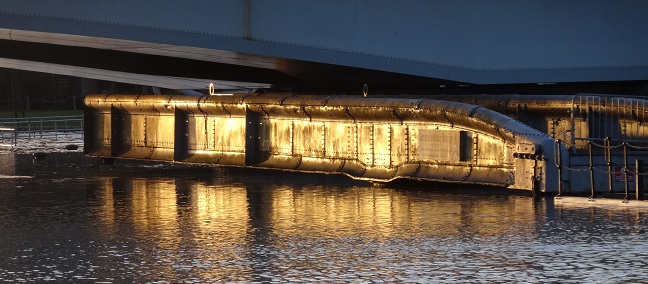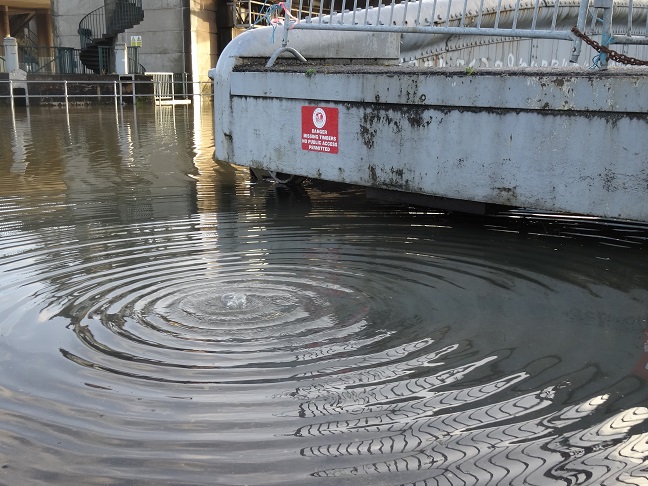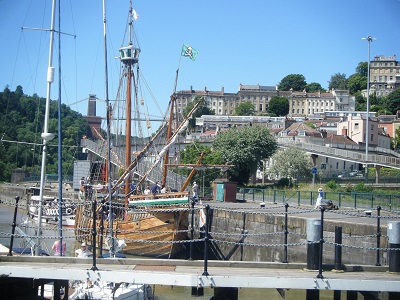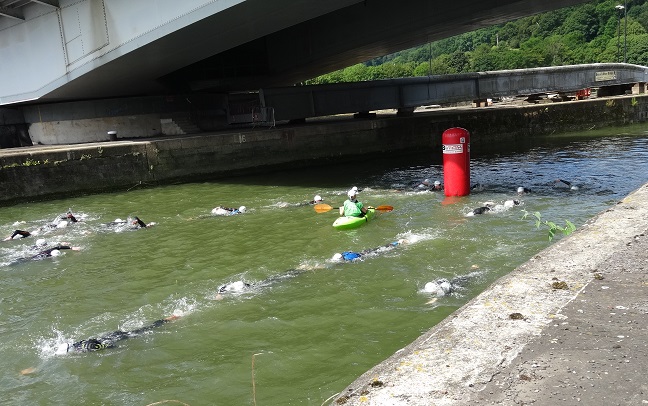Brunel Swivel Bridge Project 2014
 Brunel Swivel Bridge gets a wash in the 1st February floods |

At least we know the drain holes are working and where they are! |
 We can watch the boats go through the lock |
 Even the triathlon swimmers use the bridge as a turn round point. There is always something going on here. Great location. |
Page contents
- Work PHASE A Preparation and Basic Conservation by Volunteers
- Funding
- Photos of Progress in 2014
- December 2014: Hydraulic Ram Inspection and Test
- Nov/December 2014: Trial plate repair Investigations
- Weekend 18 October 2014
- Saturday 13 September 2014
- Saturday 16 August 2014
- Weekend 19 July 2014
- Weekend 21 June 2014
- Weekend 24+25 May 2014
- Weekend 26+27 April 2014
- Weekend 22 and 23 March 2014
- Thurs 20 February 2014
- Sat 15 February 2014
- Sun 16 February 2014
Work PHASE A Preparation and Basic Conservation by Volunteers
- Cleaning and painting rusty areas
- Unbolt and release the centre pintle casting
- Jack up Bridge a few inches
- Free up north tail wheel
- Release two rotation cables
- Lower bridge onto its pintle and track
- Free the pintle thread, rotate bridge a small amount and return to present position
- Locate and obtain copies of drawings and past reports. Write a conservation plan
- Seek letters of support
Funding
You can make a donation using a charity website. The main donation link now uses the Wonderful fundraising website: https://www.wonderful.org/charity/avonindustrialbuildingstrust
https://www.wonderful.org/charity/avonindustrialbuildingstrust
or you can send a cheque payable to
Avon Industrial Buildings Trust to:
The Treasurer,
24, The Bluebells, Bradley Stoke, Bristol BS32 8BE
Bank details for bank transfer:
Account name: Avon Industrial Buildings Trust
Account address: CAFCASH LTD
Kings Hill
West Malling
Kent ME19 4TA
Sort code: 40-52-40
Account number: 00006720
- May 2013: Clifton and Hotwells Improvement Society (CHIS), Bristol Industrial Archaeological Society (BIAS), Avon Industrial Buildings Trust (AIBT) each put in £1,000 to provide materials for the investigative work on the bridge. AIBT is the lead organisation due to its experience of this kind
- January 2014: In 2012 English Heritage offered a grant of £ 35,000 to Bristol City Council towards the original repair proposals for the bridge.
They have now looked closely into that offer and found that because it was not tied to any specific aspect of that proposal it could potentially still be made available to the revived repair project.
The main conditions to unlock that money are that it should be SPENT and CLAIMED by 31 March 2015 and that BCC would need to remain the grant recipient, meaning that, although they can delegate the
works they remain responsible for the delivery of the project (or the phase of it we may be grant aiding).
English Heritage architect Chris Miners, whom we have previously met, commended our reasonable phasing of the project, and our work so far.
- May 2014: We had a very useful meeting in Brunel House with Christina Raddon and Guy Bentham-Hill of Bristol City Council about the work to be done this financial year with the funding from English Heritage (£41k including matching funding). A programme of investigative works is being prepared by Geoff Wallis, and in addition a protective safety scaffolding will be erected. We have added a link to "know your place" a Bristol City Council website that allows you to explore your neighbourhood through historic maps, images and linked information.
- June 2014: Application for £2,930 granted by the Cabot, Clifton and Clifton East Neighbourhood Partnership for information panels, leaflets, guided walk through the Brunel structures by "Mr Brunel" on Doors Open Day in September
- October 2014: The first contract has been let in the long process of restoring the Bridge. Jon Avent of Mann Williams, Structural Engineers of Bath will be leading the team which will be carrying out investigations, trial-repairs and design work over the winter, funded by a grant from English Heritage.
We are delighted to see work by the professionals starting on site and want to thank Bristol City Council, English Heritage, the local amenity societies, our faithful hard-working volunteers, and huge number of supporters for getting the Project this far.
The big challenge lays ahead in securing major funding, but by February next year we hope to have a well-specified and costed scheme for repair which will form a sound basis for fund-raising.
- February 2015: We will have a better idea as to how much it will cost in February after all the investigative work is done.
Photos of Progress in 2014
- Photos of Progress in December 2014
- Photos of Progress in November 2014
- Photos of Progress in October 2014
- Photos of Progress in September 2014
- Photos of Progress in August 2014
- Photos of Progress in July 2014
- Photos of Progress in June 2014
- Photos of Progress in May 2014
- Photos of Progress in April 2014
- Photos of Progress in March 2014
- Photos of Progress in February 2014
2014 Working days: 15+16 February, 22+23 March, 26+27 April NOT 19+20 April 2014 (Easter), 24, 25 May, 21, NOT 22 (due to Big Bicycle Ride) June, 19, 20 July, 16, NOT 17 August, 13, NOT 14 September, 18, 19 October. Note 13 Sept is Doors Open Day
Contact Maggie Shapland (Maggie.shapland@gmail.com) if you wish to help. We need to have an idea of numbers.
December 2014 Hydraulic Ram Inspection and Test
- Release Southern Cylinder and Ram from its fixings
- Move cylinder and ram to A B Fluid Power Ltd, Newport
- Withdraw ram and gland from cylinder
- Test cast iron cylinder
- Return to site and refit
Working on hydraulic aspects. We have a quote for stripping, inspecting, x-raying and reporting on the condition of one cylinder. The cylinder was removed, ideally by grinding/flame cutting off the existing bolts and then lifting it out with a HIAB type truck
We have found that the hydraulic aspects require a level of technical input, which we have gone to experts to provide. Their scope of works will consists of providing input on the cylinder works and results, providing a performance spec for the power pack, pipework and fittings, as well as reviewing an operational strategy for if the bridge is put back into use. Their exact scope of works is difficult to quantify due to the unknown nature of the existing condition, and we are keen their price is not inflated due to the risk created by these unknowns.
As a result, we are working with the experts to make best use of the amount we have put aside from the English Heritage money for the hydraulic aspects.
November/December 2014 Trial plate repair Investigations
Dorothea Restorations are in the process of progressing investigations to inform the repair and restoration of the bridge structure. As part of these works we are looking to carry out some trial repairs on a small number of selected areas of plate and riveted locations. The aim is to select areas that are either in an advanced state of decay, or where there are later plated repairs to the original structure.Investigations show that the side plates of the triangle are probably in good condition for much of the length of the Bridge, but that the bottom 3-4 inches has corroded severely on the inside causing general outward distortion and holing. The trials currently in progress will adequately demonstrate the method of repair to these areas, and can be applied generally on both sides of the girders except where transoms abut.
This area cannot be accessed in the future without cutting through sound original material or our repair, so we have agreed to carry out a permanent repair now as follows:
- Remove rivets, dismantle inner and outer lap-plates, clean and paint with a 2-pack epoxy system, 250 micron minimum.
- Cut out a 2-3 inch wide strip of severely corroded soffit-plate adjacent the lap-plate.
- Supply a piece of steel to match the soffit thickness and curvature, butt-weld to the soffit plate all round. The repair plate must be veed out for a full-depth weld.
- Blast clean and epoxy- paint the area generally with 250 micron minimum dft.
- Refit the existing lap-plates bedded on mastic tape to fully exclude water. Secure with hot-set rivets where visible on the outside and friction-grip bolts underneath.
- Supply a new 1/4 inch thick curved front plate, clean and paint both sides with 2-pack epoxy paint, 250 micron. Rivet along the bottom edge, butt weld around the sides and top. Dress off, make good to paintwork.
Weekend 18 October 2014
This was our last official workday of the year, although surveying and contractor's work will continue over the winter. On Saturday we had a 'conference of engineers' when Bob Waite, John Ditchfield and Graham Laucht joined our Technical Panel to discuss some of the mysteries relating to the construction of the Bridge, such as how they bent long plates and riveted up very long tubes, how were the tie-rods inside the tubes tensioned, etc.Our discussions were long, animated, interesting and helped our understanding of this amazing structure. Maggie videoed George Waite waxing lyrical about his time as a practical boiler-maker, and the many practical skills he became proficient at, which would have also been used on the Bridge.
Bob and Martyn continued surveying levels with borrowed equipment, whilst our new volunteer Alessandra, young Charlie, and Maggie continued to descale the inside of the structural center-boxes and paint them with an extended brush so that they didn't breath too many paint-fumes. Geoff used a borrowed endoscope to investigate the tie-rods inside the top-tubes, and of course, there was lots of discussion about how to raise funds, as we need about £1 million to complete the work!
Saturday 13 September 2014
Our first open day, participating in Heritage Doors Open Day.We had 158 interested visitors, good weather and a visit from Mr Brunel who led a walk of 45 from the SS Great Britain with the able help of Mike Bone. Over 50 people signed the support sheets - we had to use the reverse of these sheets to capture all the names.
The 2 boards of photos/drawings etc attracted a lot of attention. One visitor used to be a blacksmith in Underfall Yard and did repair work on the bridge in 1959/1960! There are photos of volunteers wearing our Brunel hat plus a number of visitors who also put it on.
Mr Brunel's walk was a very good way to get the message across.
Saturday 16 August 2014
Good progress today with Maggie, Ian and Graham on air-chisels/paint, Geoff and nephew Josh on jacks to raise the bridge where it had subsided, and Martyn on ultrasonics. Martyn tried out an ultrasonic thickness gauge kindly loaned by the Docks Engineer to see if we could reliably determine where the rust is inside the enclosed spaces. The trials were encouraging, so we are now thinking of buying our own instrument.Mike T boarded up the holes in the north abutment piers to prevent rubbish (and worse) being dumped inside, and spent ages picking up rubbish from all over the Island. Mike you are a hero...thank you!
Bob has been producing amazing CAD drawings of all the parts of the Bridge and predicted that there would be large timber beams just under the ground, supporting the turn-table wheels. Mike B, Josh and Bob dug down to see if they existed, and sure enough discovered a 12 inch square baulk to everyone's delight. Hammering a screwdriver into it revealed that most of the timber was sound, although damp, and it smelled strongly of tar, so presumably had been treated when installed.
We were delighted to see Bretton, Vince and Tom again, our three local engineer-volunteers who we hope will soon be helping Bob to carry out a levels and theodolite survey, and develop ideas for restoring/adapting the existing hydraulic rams for use again.
Come and join us on 13-14th September for our next work-days, which also coincides with Doors Open Day. No experience is necessary, and youl'll find a warm welcome.
Weekend 19 July 2014
We had our first glimpse of the area under the bed-plate of the Swivel Bridge today, see photos. The four turn-table support-wheels are housed in cast iron sumps bolted to the underside of the bed-plate. We raised the south east wheel about a foot, and after excavating lots of 'long-term debris' found a drain-hole in the bottom. A video endoscope was poked in and found a void about 400 mm deep underneath the sump.The remains of a large, decayed (? softwood) bearer can be seen in the photos. (The white stalk visible is a root, with a wood-louse on the end). The drawings of the original Bridge footings show large timbers supporting the bed-plate, so the same practise, indeed the same timbers, may have been used when the structure was moved to its present site.
The two western wheels also have big voids underneath. No drain-pipes are connected to the holes in the sumps, so presumably water has been draining into the area under the bed-plate for years, and the timbers have rotted away. Not good news. We'll investigate the fourth wheel and its sump tomorrow.
Weekend 21 June 2014
Wonderful sunny weather and the opportunity of seeing the Matthew and Tower Belle going through the lock twice provided a great setting for some useful work on the Swivel Bridge. We erected a simple scaffold and hoisted out two of the heavy cast iron wheels that support the whole structure. The bearings of the north west wheel were in good order, but one of the shafts on the SW bearing was heavily corroded, and this had badly worn the brass shell supporting it. The brass is removable and can be replaced, but the shaft is more of a challenge that will require some real engineering.Both wheels sit in cast iron 'sumps' that were completely full of debris and water. Once this was removed we discovered 30 mm diameter drain holes. To our surprise a bucketful of water thrown in immediately gurgled away, and didn't exit in the Harbour. This may suggest that the area under the bed casting is hollow, which raises questions about the nature of the support structure. Brunel's original drawings show large wooden bearers, but of course the structure has been moved from its original site.
Martyn and Geoff then had a happy time working in the restricted space under the north tail-wheel removing, cleaning and checking the two bearings. They are in fine condition, but the challenge was to avoid the wheel dropping off its jacks and trundling off into the Harbour! Suitable precautions were taken, and the Bridge still has two tail-wheels.
We realised that when the bridge is restored it will be a lot easier if one can gain access to the bridge from above as well as below! It is so much easier this year with the bridge jacked up! We can often sit up! Who knows when the wheel pits were cleared out last, but it is vital that they are kept clear in the future. The floods in January and February did not help either.
No work on Sunday since big bike ride made access to the site impossible.
Weekend 24+25 May 2014
This weekend was our ‘serious heating’ session as Dorothea Restorations Ltd had kindly lent us oxy-propane gas bottles and heating gear (and their van!). As one might expect on a Bank Holiday weekend Saturday was continuous rain, but Maggie, Mike, Ian and Geoff arrived bright eyed and bushy tailed and soon had a ‘tarp tent’ erected. We slotted our giant spanner over the giant 150mm square central adjusting nut and rigged up two 2 Tonne chain hoists to pull it round. It was rusted solid so we heated it to expand its outer sleeve, and pulled,…… and heated and pulled…..and heated and hammered and pulled...to no effect. We concluded that FOUR heating torches all working together would be needed to move the giant seized adjusting nut.Next we heated and hammered free the two 50mm diameter pins securing the ends of the old haulage ropes that once rotated the Swivel Bridge. To remove the pin Mike jacked it up with our 50T hydraulic jack until it slipped through its rust hole with a loud, satisfying BANG….. he hadn’t had so much fun for years!
Sunday dawned bright so we stood for an hour and a half on the centre of the Bridge to consider what to do about our seized central adjuster. We wanted to remove it to gain access to the internals for inspection & conservation, and to allow adjustment and future maintenance, but we felt that heating the ancient ironwork with numerous torches might distort it and melt white-metal (like solder) which we had found inside. We brain-stormed methods of cutting out the adjuster by core or chain drilling, or by some other high-tech process. Then we went back to basics and asked ourselves what the adjuster was for. It is too small to support the structure and anyway there are four wheels to do that. It doesn’t hold the bridge central because it is too high up, and there is a large bearing elsewhere to resist the 10T force of the hydraulic rams that rotate the Bridge. So we concluded that the giant adjuster was to retain a sleeve which we figured out could be secured by another, reversible, method. We therefore decided that the adjuster was probably virtually redundant and that the best treatment was that very best of conservation policies….TO DO NOTHING…the low-risk, cheap, and reversible solution that ticks all the boxes! Whilst the gas equipment was available on site we removed rusted nuts on the hydraulic rams which turned the Bridge and a seized part on the original control valve.
So, altogether a productive and satisfying weekend, despite its wet start.
Weekend 26+27 April 2014
The enthusiasm of our volunteers was not dampened by intermittent rain, and we achieved much. Descaling and painting of the highly-stressed but heavily-corroded central box-beams continued, as did the jacking of the tail end of the structure.Jacking up 60 Tonnes manually is hard work, particularly as the support timbers compress slightly causing wasted effort, but it is satisfying to see that the weighted end is now about 500 mm above ground, making access to the turn-table and support wheels possible.
We had our first real glimpse of the internals of the giant cast iron pintle (literally 'little pin';) around which the Bridge revolves, and it is clear that some repairs and renewals will be needed here.
We removed the steel covers of the two pits containing the hydraulic rams that rotated the deck structure, and started work cleaning and freeing them. A few calculations showed that each ram could pull with a force of 11 Tonnes, so it is not surprising that the central bearing that keeps the Bridge in place has worn!
The big square-headed adjuster above the central bearing is thoroughly seized due to decades of rusting, and this must be freed to allow repair and adjustment. Plans have been made to attempt this at our next volunteer days on 24-25th May, so why not come and help?'
Weekend 22 and 23 March 2014
We installed restraints to prevent the Bridge from sliding, and continued to raise the tail-weight so as to give access to the turn-table wheels. All went well, but pumping 50T jacks is very hard work, and humping railway sleepers about is even harder.Our heroic team from Bath University and our hard-working new-comer Ian did wonders removing heavy rust from inside the main box-girders which was a difficult, noisy, dusty job, but these are now partially painted, so well-done all. These wrought iron boxes are critical to the strength of the Bridge structure, so you have slowed down their deterioration considerably. THANK YOU!
Lots of supportive interest from passers-by, and thanks for helping us again young Charlie and Dad.
Photos of Progress in March 2014
Thursday 20 February
At no time have we raised the free end of the Brunel Swivel Bridge nearer to the underside of the Plimsoll Bridge, which would cause problems when opening it due to lack of clearance. We have instead lowered it as set out on the method-statement forwarded to the Dockmaster. Jacking diagramWe have blocked the free end of the deck 9m from the end to provide a pivot point, so that as the tail (west) end is raised the free (east) end falls, giving greater clearance under Plimsoll Bridge. Before we started any work we set up measuring points around the bridge and carefully recorded clearances of the side-girders above ground. The free end was 572mm above the ground before we started, and 545mm Thursday morning, confirming that we had lowered the nose by 27mm. As the tail end had settled slightly we raised it a further modest amount so that on completion the nose was 523 mm above the ground. This means that we have lowered the free end by 49 mm, increasing the clearance under the Plimsoll bridge by about 50% since we started work.
Saturday 15 Febrary 2014
Our first weekend workdays of 2014 were threatened by bad weather, but six of us plus our young apprentice Charlie arrived at 10.00 am on Saturday with our waterproofs. We had a clear plan and lots of enthusiasm, but were at the mercy of the weather.Our aim was to raise the Bridge 6 inches to take the weight off the two sets of wheels supporting the Bridge so that we could start refurbishing them. But, sure enough, soon after we got out our two lovely new 50T jacks (courtesy of CHIS and BIAS), the heavens opened and we spent twenty minutes sheltering under the Plimsoll Bridge watching hail and torrential rain whilst enjoying Maggie's delicious home-made fruit-crunch.
The storm cleared and we started jacking. Soon the 50T back end of the Bridge started to rise but to our dismay the jacks started sinking into the sodden ground. With steel plates for load-spreading, sand to fill the depressionsl and lots of ingenuity we raised the rear end of the Bridge 40 mm but to our surprise and horror the middle didn't follow! We expected a degree of flexibility in the old wrought iron structure, but not as much as we found. Being British we stopped work, had a cup of tea, and thought.
The north side of the Bridge was behaving as expected with about 20 mm deflection along its length, but the south side was more flexible by a factor of 3 or 4. Decades ago a ship ran into the Bridge and its top tube was damaged. It was repaired, (you can clearly see the welded section if you look carefully,) but inside Brunel had placed a substantial tension-rod to keep the structure rigid. It seems likely that this tie-rod was not tensioned during the repair, so that the whole side-beam was more flexible than Brunel intended, and had sagged, and we had simply unbent it. This is a significant discovery that will inform the planned restoration programme.
Photos of Progress in February 2014
Sunday 16 February 2014
On Sunday, now that we understood the cause, we were confident we could continue to raise the tail of the Bridge without causing it any distress, and continued until it was lifted 5 inches where it was safely blocked on six giant, creaking timbers.Meanwhile our two hardworking new volunteers Hannah and Simon had spent the whole day with pneumatic guns chiselling off thick rust in a structurally-vital but somewhat inaccessible part of the structure. Finally they applied two-pack paint which will provide protection until full refurbishment can take place.
Photos of Progress in February 2014
 Brunel's Other Bridge
Brunel's Other Bridge